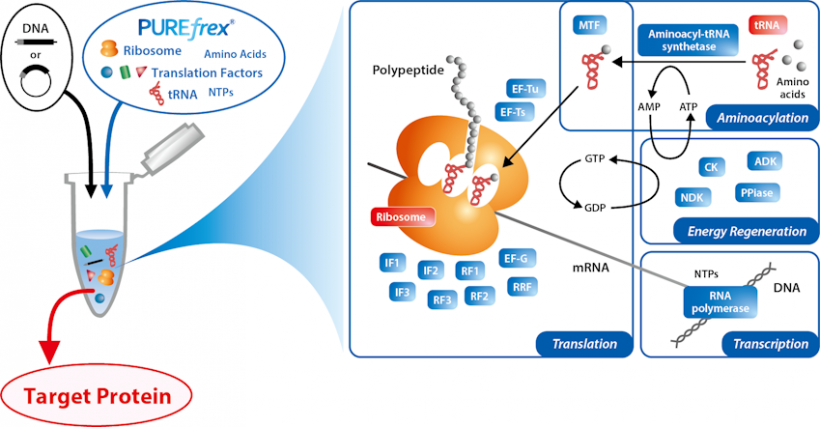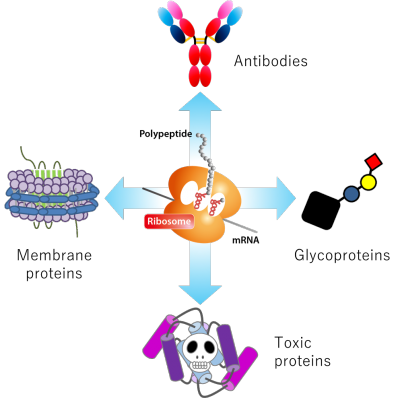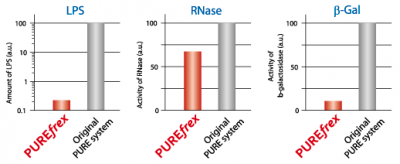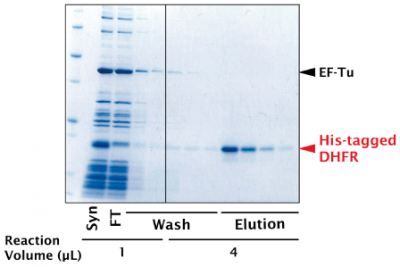Overview
PUREfrex® kit is a reconstituted in vitro Coupled Transcription/Translation Systems, completely different from an E. coli extract S30 system.
By adding DNA or mRNA that encodes the target protein to the reaction solution, proteins can be synthesized easily and quickly without using living cells.
PUREfrex® is a series of newly developed reconstituted cell-free protein synthesis reagent based on PURE (Protein synthesis Using Recombinant Elements) system technology invented by Professor Takuya Ueda in the University of Tokyo (Ref. 1, 2). The most important feature of this system is the RECONSTITUTED system, which collects only transcription and translation-related factors. This unique property allows the user to freely adjust the composition of the reaction mixture. Also, since it contains only known proteins and substrates, there is no need to consider serious background issues in assays, etc., that are performed after protein synthesis.

1. Shimizu et al. (2001) Nat. Biotecnol., vol. 19, p. 751
2. Shimizu et al. (2005) Methods, vol. 36, p. 299
Video – How to use PUREfrex –
Contamination test
By improving the purification process of components in PUREfrex® kit, contamination of RNase and β-galactosidase are greatly reduced, in addition to that, lipopolysaccharide (LPS) is also reduced to less than 1 EU per 1 µL of reaction mixture.
Affinity tags
All proteinous components of PUREfrex® kit have no tags for purification and detection. It allows to fuse your protein with any tag to purify the product.
Supplements
Depend on your protein’s property, we have supplements to add to PUREfrex® kit. Molecular chaperones, DnaK Mix or GroE Mix, are for improving folding and solubility. DsbC Set or PDI Set are for making disulfide bonds. Depending on each protein, adding those supplements to PUREfrex® kit helps effective translation and folding simultaneously.
Chaperones
Molecular chaperones such as hsp70 (e.g. E. coli DnaK) assist the correct folding of the newly synthesized proteins. Because PUREfrex® does not contain any molecular chaperones, some proteins may have difficulty in forming the correct conformation and be insoluble after synthesis. In such cases, molecular chaperones could contribute to make them soluble and active.
Forming disulfide bonds
For some proteins, such as secretory proteins, formation of a disulfide bond is important for their stability or activity. Disulfide bonds are usually formed by the oxidation of sulfhydryl groups (SH-) of adjacent cysteine residues. Therefore, oxidized environment is necessary to form a disulfide bond. Additionally, disulfide bond isomerase (e.g. E. coli DsbC), which can catalyze the disulfide bridge exchange, is also necessary to form a correct paring of cysteines.
Application
There are examples of synthesizing various active proteins using PUREfrex® kit.

In addition, PUREfrex® can be used for various purposes such as display techniques such as mRNA display and ribosome display (RD), introduction of unnatural amino acids, and translation mechanism research.
PUREfrex® is suitable for small-scale, high-throughput synthesis of a wide variety of proteins, and is also ideal for protein function evaluation platform for machine learning.
On the Resources page, you can find posters and technical notes about PUREfrex.
Additionally, there are papers that use PUREfrex or PURE system technology.
For preparation of following proteins
prokaryotic protein
eukaryotic protein
membrane protein
protein containing disulfide bonds
protein containing unnatural amino acids
… etc.
For basic research in protein science
Translation
Folding of protein after synthesis
Note
PUREfrex® is developed for in vitro research only. PUREfrex® should not be used for the therapy, diagnostic or administration to animals including human and should not be used as food or cosmetics etc. To avoid the contamination of nuclease, nuclease-free-treated water, reagents and materials should be used. We also recommend wearing gloves and mask.
“PUREfrex® is Registered in U.S. Patent and Trademark Office”


